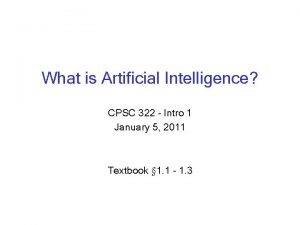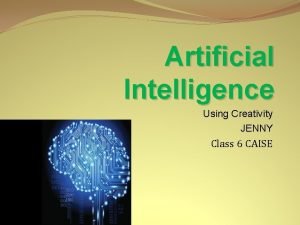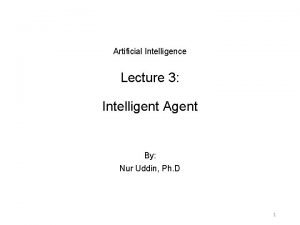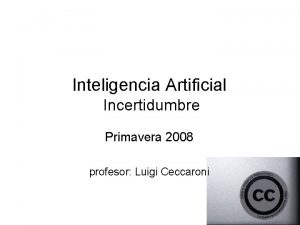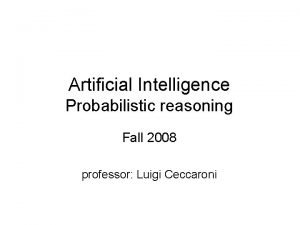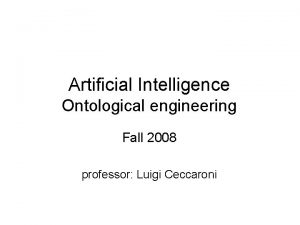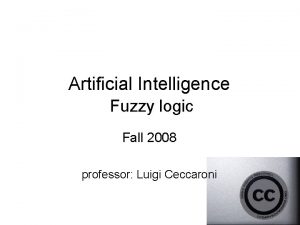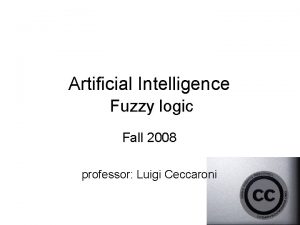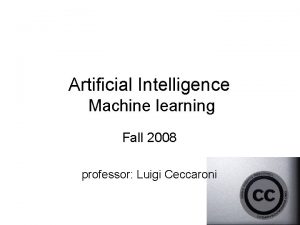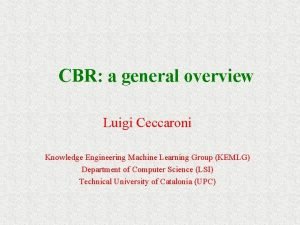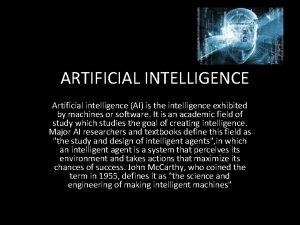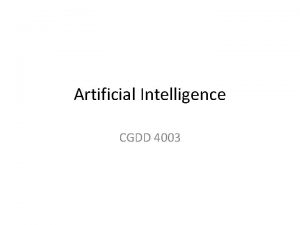Artificial Intelligence Introduction Fall 2008 professor Luigi Ceccaroni






![Topics • [ 1. ] Search – [1. 1] Problem representation – [1. 2] Topics • [ 1. ] Search – [1. 1] Problem representation – [1. 2]](https://slidetodoc.com/presentation_image_h/a1ae1911543afcd45a4942ac6e396d14/image-7.jpg)
![Topics • [2. ] Knowledge representation and inference – [2. 1] Methodologies for knowledge Topics • [2. ] Knowledge representation and inference – [2. 1] Methodologies for knowledge](https://slidetodoc.com/presentation_image_h/a1ae1911543afcd45a4942ac6e396d14/image-8.jpg)
![Topics • [3. ] Knowledge-based systems – [3. 1] Definition and architecture – [3. Topics • [3. ] Knowledge-based systems – [3. 1] Definition and architecture – [3.](https://slidetodoc.com/presentation_image_h/a1ae1911543afcd45a4942ac6e396d14/image-9.jpg)
![Topics • [ 4. ] Natural language – [4. 1] Textual, lexical and morphological Topics • [ 4. ] Natural language – [4. 1] Textual, lexical and morphological](https://slidetodoc.com/presentation_image_h/a1ae1911543afcd45a4942ac6e396d14/image-10.jpg)
![Topics • [ 5. ] Machine learning – [5. 1] Decision trees Topics • [ 5. ] Machine learning – [5. 1] Decision trees](https://slidetodoc.com/presentation_image_h/a1ae1911543afcd45a4942ac6e396d14/image-11.jpg)














- Slides: 25

Artificial Intelligence Introduction Fall 2008 professor: Luigi Ceccaroni

Instructors • Luigi Ceccaroni – Omega building - Office 111 – luigi@lsi. upc. edu • Núria Castell Ariño – FIB building - Second floor – castell@lsi. upc. edu

Course description • This course introduces: – Representations – Techniques – Architectures • This course also explores applications of: – – – – • Rule chaining Heuristic search Constraint propagation Constrained search Decision trees Knowledge representation Knowledge-based systems Natural-language processing It accounts for 7. 2 credits of work load, distributed as: – 3. 6 credits for theory – 2. 4 for recitations – 1. 2 for laboratory

Web pages • http: //www. lsi. upc. es/~bejar/ia/ia. html • http: //www. lsi. upc. edu/~luigi/MTI/AI-2008 fall/ai. html • http: //raco. fib. upc. es/

Background • Students need the following knowledge (at the undergraduate level) to appropriately follow the course: – English language – Propositional and predicate logic; capacity to formulate a problem in logical terms – Logical inference; strategies of resolution; capacity to solve problems by resolution – Graph and tree structures; algorithms for search in trees and graphs – Computational complexity; calculation of algorithm execution's cost • There assignments that expect students to be able to read and write basic Java. This is the only formal prerequisite.

Aim of the course • The general objectives of the course can be summarized as: – To identify the kind of problems that can be solved using AI techniques; to know the relation between AI and other areas of computer science. – To have knowledge of generic problem-solving methods in AI. – To understand the role of knowledge in present IA; to know the basic techniques of knowledge representation and their use. – To be able to apply basic AI techniques as support for the solution of practical problems. – To be able to navigate the basic bibliography of AI.
![Topics 1 Search 1 1 Problem representation 1 2 Topics • [ 1. ] Search – [1. 1] Problem representation – [1. 2]](https://slidetodoc.com/presentation_image_h/a1ae1911543afcd45a4942ac6e396d14/image-7.jpg)
Topics • [ 1. ] Search – [1. 1] Problem representation – [1. 2] Search in state space – [1. 3] Uninformed search – [1. 4] Informed search (A*, IDA*, local search) – [1. 5] Games – [1. 6] Constraint satisfaction
![Topics 2 Knowledge representation and inference 2 1 Methodologies for knowledge Topics • [2. ] Knowledge representation and inference – [2. 1] Methodologies for knowledge](https://slidetodoc.com/presentation_image_h/a1ae1911543afcd45a4942ac6e396d14/image-8.jpg)
Topics • [2. ] Knowledge representation and inference – [2. 1] Methodologies for knowledge representation – [2. 2] Rule-based systems – [2. 3] Structured representations: frames and ontologies
![Topics 3 Knowledgebased systems 3 1 Definition and architecture 3 Topics • [3. ] Knowledge-based systems – [3. 1] Definition and architecture – [3.](https://slidetodoc.com/presentation_image_h/a1ae1911543afcd45a4942ac6e396d14/image-9.jpg)
Topics • [3. ] Knowledge-based systems – [3. 1] Definition and architecture – [3. 2] Expert systems – [3. 3] Knowledge engineering – [3. 4] Approximate reasoning
![Topics 4 Natural language 4 1 Textual lexical and morphological Topics • [ 4. ] Natural language – [4. 1] Textual, lexical and morphological](https://slidetodoc.com/presentation_image_h/a1ae1911543afcd45a4942ac6e396d14/image-10.jpg)
Topics • [ 4. ] Natural language – [4. 1] Textual, lexical and morphological analyses – [4. 2] Levels of natural language processing – [4. 3] Logical formalisms: definite clause grammars – [4. 4] Applications and current areas of interest
![Topics 5 Machine learning 5 1 Decision trees Topics • [ 5. ] Machine learning – [5. 1] Decision trees](https://slidetodoc.com/presentation_image_h/a1ae1911543afcd45a4942ac6e396d14/image-11.jpg)
Topics • [ 5. ] Machine learning – [5. 1] Decision trees

Bibliography • There are no required readings, apart from the course lecture notes. Additional reading can be found in the following text: – Russell, Stuart J. and Peter Norvig – Artificial intelligence: a modern approach. 2 nd edition – Upper Saddle River, NJ: Prentice Hall, 2002 – ISBN: 0137903952.

What is AI? • There is no single definition, but several approaches, that Russell-Norvig summarize in four main ones. • These approaches follow different points of view. • Their influences are diverse (Philosophy, Mathematics, Psychology, Biology. . . ). • Their fields of application are ample and interrelated.

Approaches to AI • Systems that act like humans – The study of how to obtain that computers perform tasks at which, at the moment, people are better (Rich and Knight, 1991) • Systems that think like humans – The effort to make computers think. . . machines with minds in the full and literal sense (Haugeland, 1985) • Systems that think rationally – The study of the mental faculties through the study of computational models (Charniak and Mc. Dermott, 1985) • Systems that act rationally – The effort to explain and emulate the intelligent behavior in terms of computational processes (Shalkoff, 1990)

Other approaches to AI • Good Old-Fashioned Artificial Intelligence (GOFAI) (Douglas Lenat: Cyc) – Cramming a computer full of knowledge about the real world and methods to manipulate it – Intelligence intimately tied up with having and being able to use knowledge – “It’s worth to go to school” – Robotic insects example • Legs controlled by a central computer that has a detailed 3 D map of the terrain and knows all the relevant laws of physics and strategies 15

Other approaches to AI • Learning through experience (Rodney Brooks: Cog, Kismet) – Machines that experience the world in much the way human beings do – “You can learn stuff on your own” – Robotic insects example • Each leg containing a small circuit that tells it about basic movements • All local computation physically coupled through the body, with gait emerging spontaneously from 16 circuits’ interaction

Areas of work in AI • Theory • Philosophy • Applications

Turing test

The Chinese room (John Searle)

Eliza (1966) • Conversation with ELIZA E> Hello. I am ELIZA. How can I help you? P> I am feeling sad. E> I am sorry to hear you are sad. P> I had some nightmares tonight. E> You say you had some nightmares tonight? P> Yes, my dreams are worrying me. E> What does that dream suggest to you? P> Thrill, scare. E> I am not sure I understand you fully. P> My dreams annoy me. E> Do you dream often? P> Yes, daily.

Lost in translation English → Russian (or Spanish)→ English “The spirit is willing, but the flesh is weak” → → Дух охотно готов, но плоть слаба → → “The vodka is good, but the meat is rotten” (Actually: “Spirit is willingly ready, but flesh is weak” or “The alcohol is arranged, but the meat is weak”)

Autonomous robots

Personalization, recommendation

US District Court judge John E. Jones III • Proponents of intelligent design argued that their supposedly scientific alternative to evolutionary theory should be presented in biology classes. • “An objective student can reasonably infer that the school’s favored view is a religious one, and that the school is accordingly sponsoring a form of religion. ”

One book • What if I want to read just one book about artificial intelligence? Darwin's Dangerous Idea by Daniel Dennett In favor of materialistic Darwinism Victims: Noam Chomsky, Roger Penrose, John Searle and, specially, Stephen Jay Gould
 Pxdes expert system
Pxdes expert system Cpsc 322: introduction to artificial intelligence
Cpsc 322: introduction to artificial intelligence Cpsc 322: introduction to artificial intelligence
Cpsc 322: introduction to artificial intelligence 2008 2008
2008 2008 Promotion from associate professor to professor
Promotion from associate professor to professor Mycin expert system architecture
Mycin expert system architecture State space artificial intelligence
State space artificial intelligence Searching for solutions in artificial intelligence
Searching for solutions in artificial intelligence 15-780 graduate artificial intelligence
15-780 graduate artificial intelligence Knowledge manipulation in artificial intelligence
Knowledge manipulation in artificial intelligence Structural knowledge in ai
Structural knowledge in ai Vandelay art. seinfeld the show about nothing. penguin 1997
Vandelay art. seinfeld the show about nothing. penguin 1997 Kecerdasan kepemimpinan
Kecerdasan kepemimpinan Uas kecerdasan buatan
Uas kecerdasan buatan Math and artificial intelligence
Math and artificial intelligence Peas properties in ai
Peas properties in ai 15-780 graduate artificial intelligence
15-780 graduate artificial intelligence Xkcd
Xkcd Fuzzy propositions examples
Fuzzy propositions examples Cse 571 asu
Cse 571 asu 15 780
15 780 What is informed search and uninformed search
What is informed search and uninformed search What is artificial intelligence class 6
What is artificial intelligence class 6 Augmented grammar in ai
Augmented grammar in ai Omniscience in artificial intelligence
Omniscience in artificial intelligence What is the alan turing test
What is the alan turing test

